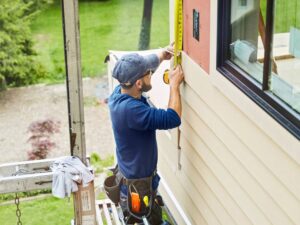Siding Companies Charleston SC keeps water from penetrating the home’s structure, where it can cause all kinds of damage. It also makes the building less attractive to termites and carpenter ants.
Regularly walk around your property and inspect the cladding for any problems that should be addressed before they worsen. Performing timely siding repairs can help you avoid costly and extensive repairs in the future.

If a section of your vinyl siding is cracked, water or debris can penetrate beneath the panel, possibly leading to mold, mildew, or other moisture-related problems. Often, this indicates that you have further issues with your home’s exterior, which may require replacement rather than repair. If you notice this type of damage, acting quickly is important.
To repair a cracked or broken piece of siding, start by cleaning the damaged area with soap and water and allowing it to dry for about two hours before you begin. Next, remove any nails or screws that hold the panel in place. Then, carefully unlock the upper and lower panels from each other by pulling down on the top panel. A special vinyl siding removal tool, also known as a zip tool, can be purchased online or at your local home center to make this process easier.
Cut a patch from a piece of leftover siding, ensuring it extends about two inches farther on each side than the hole or crack you are repairing. Find a patch piece the same color as the existing siding on your house, although this may not always be possible if your vinyl has faded over time.
Load a caulking gun with waterproof caulk and apply a small bead around the edge of the patch, then press it into the hole or crack and push outward to ensure that it adheres properly. Allow the caulk to fully dry before applying paint.
If you do not have a patch of the same siding color, take a sample to a supply company specializing in vinyl siding and request a replacement for your specific type. You can also ask a professional siding installer for help finding a match. If you’re lucky, you can find a full-length piece of siding left over from the last time your home was sided. Many homeowners have the foresight to save the leftover pieces, and you can find them on a shelf in your garage or tucked away under a garage awning.
Sagging siding is a major sign that your home needs repair. It can expose the underlying structure and joists to moisture and pests, which can cause serious damage over time. This damage may lead to wood rot, water leaks, and structural failure. Sagging siding is also unsightly and can affect your property value. It makes your home or commercial building look unkempt and uncared for.
It’s important to fix sagging siding as soon as you notice it. This will help prevent the problem from worsening and keep your house watertight and safe from damage. Various factors, including temperature changes and water infiltration, can cause sagging siding.
If you need clarification on what’s causing your sagging siding, hiring an experienced professional for inspection and repair is best. They can determine the source of the problem and recommend the most effective solution. Depending on the severity of the issue, you might need to replace your entire siding or repair a damaged section.
Generally, it’s a good idea to do an annual walk around your home and note any problems you see. This will help you spot any issues before they become more severe and costly. Aside from sagging and warped siding, it would be best to watch for signs of insect infestation, such as holes where nails used to be and rotting wood.
Several things, including improper installation and temperature changes, can cause sagging siding. If you’re having this problem, finding a quality contractor to install your siding properly is a good idea. They’ll be able to ensure that your vinyl siding is thick enough to withstand weather extremes, and they’ll install it with the correct spacing.
In addition, you should also make sure that your siding is nailed into the sheathing and joists correctly. Vinyl moves a lot with temperature changes, so the nails should be spaced 16 to 18 inches apart to allow them to expand and contract without causing problems.
Water damage is an ever-present threat to siding; even the best-made and maintained materials can succumb. When water infiltrates the boards, they can become soft and weak, making them prone to cracking, warping, and inviting other problems like mold and mildew growth.
Fortunately, you can watch for several warning signs to identify water damage before it becomes a serious problem.
These stains are a telltale sign of water damage to your home’s exterior. If you see these stains on the outside of your house, water has likely been leaking behind your siding for some time, and a thorough cleaning and possibly some replacement work will be required to fix the issue.
This is a particularly nasty symptom of water damage to your siding, and it can result in severe problems that may affect the structural integrity of your home. If you spot dry rot on the exterior of your house, it is important to contact a professional contractor for an evaluation and repair.
When vinyl siding deteriorates and allows water to penetrate, it can lead to vertical cracks that eventually undermine your home’s foundation. This is not only a major safety hazard, but it can also be costly to repair and may require invasive remodeling work to address the root cause of the problem.
A common problem that homeowners experience with their vinyl siding is water leaks. This is typically the result of damaged or missing flashing that prevents water from flowing away from your home. Lost or damaged caulking can also create an entry point for water into your walls.
To help protect your vinyl siding from leaks, regularly check the caulking around your windows and doors and replace it as needed. You can use paintable caulking to fill small surface cracks, sunken nail holes, or other areas susceptible to moisture intrusion. However, it would be best not to seal up the weep holes of your windows, as they are necessary for water to escape when it rains or snows.
When fire damage occurs, there are several things to consider regarding restoration work. First and foremost, an expert should assess the damage and determine what steps must be taken to repair or replace the siding. This includes fencing the property, removing debris and boarding up openings in the structure, and deploying tarps to cover vulnerable roof parts. Depending on the level of damage, there may also be structural issues that need to be addressed.
Once the damage has been assessed, it’s time to contact an insurance provider. They will send an adjuster to inspect the siding and provide a cost estimate for any necessary replacement or repair work. They will also determine what type of coverage the homeowner has and if there’s a deductible to pay before reimbursement can be obtained.
If a recent wildfire has damaged your home, the siding will likely be destroyed and must be replaced. If the fire caused the damage, your insurance company will pay for the new siding and any other restoration needed.
In addition to the obvious fire damage, there is likely a lot of smoke residue and odor on your home’s exterior. This can stain your siding, leaving unsightly streaks and stains. It’s important to wash your home’s siding as soon as possible after any fire damage so the staining doesn’t have a chance to set in.
Many siding materials aren’t very resistant to fire so that they will melt after prolonged exposure to the heat of a wildfire. However, there are a few products that do very well in terms of fire resistance. For example, traditional stucco and some synthetic stucco receive very high marks when tested against other fire-resistant materials and achieve a one-hour fire rating. This gives homeowners more time to escape their homes before the fire reaches the interior walls.
While you’re working to repair your siding after a fire, this could be a great opportunity to upgrade your home and make some much-needed improvements. If you’ve always wanted a new kitchen, an open floor plan, or an extra bathroom, now is the perfect time to discuss what can be done during this restoration process.

